I had to solve the following problem:-

9 values, from 1 to 9 (0 and 10 not accepted) and all numbers need to be different.
To solve the problem, I made those horrible for loops inside for loops.
(I added 2 more conditions to check if I had one of the solutions)
It is working, but I was wondering how to create those for loops inside for loops in a better way?
Also, each number can't be equal to another. How can you accomplish this another way than I did? (Again, 2 first conditions can be deleted)
Here is code:
var a = 1,
b = 1,
c = 1,
d = 1,
e = 1,
f = 1,
g = 1,
h = 1,
i = 1
var x = 0
var result = []
function calc() {
x = a + (13 * b) / c + d + 12 * e - f - 11 + (g * h) / i - 10
if (x == 66) {
result.push([a, b, c, d, e, f, g, h, i])
}
}
for (a = 1; a < 10; a++) {
calc()
for (b = 1; b < 10; b++) {
calc()
for (c = 1; c < 10; c++) {
calc()
for (d = 1; d < 10; d++) {
calc()
for (e = 1; e < 10; e++) {
calc()
for (f = 1; f < 10; f++) {
calc()
for (g = 1; g < 10; g++) {
calc()
for (h = 1; h < 10; h++) {
calc()
for (i = 1; i < 10; i++) {
calc()
}
}
}
}
}
}
}
}
}
console.log(result)
var result2 = result.filter(function (el) {
return (
el[0] == 5 &&
el[1] == 9 &&
el[0] != el[1] &&
el[0] != el[2] &&
el[0] != el[3] &&
el[0] != el[4] &&
el[0] != el[5] &&
el[0] != el[6] &&
el[0] != el[7] &&
el[0] != el[8] &&
el[1] != el[0] &&
el[1] != el[2] &&
el[1] != el[3] &&
el[1] != el[4] &&
el[1] != el[5] &&
el[1] != el[6] &&
el[1] != el[7] &&
el[1] != el[8] &&
el[2] != el[0] &&
el[2] != el[1] &&
el[2] != el[3] &&
el[2] != el[4] &&
el[2] != el[5] &&
el[2] != el[6] &&
el[2] != el[7] &&
el[2] != el[8] &&
el[3] != el[0] &&
el[3] != el[1] &&
el[3] != el[2] &&
el[3] != el[4] &&
el[3] != el[5] &&
el[3] != el[6] &&
el[3] != el[7] &&
el[3] != el[8] &&
el[4] != el[0] &&
el[4] != el[1] &&
el[4] != el[2] &&
el[4] != el[3] &&
el[4] != el[5] &&
el[4] != el[6] &&
el[4] != el[7] &&
el[4] != el[8] &&
el[5] != el[0] &&
el[5] != el[1] &&
el[5] != el[2] &&
el[5] != el[3] &&
el[5] != el[4] &&
el[5] != el[6] &&
el[5] != el[7] &&
el[5] != el[8] &&
el[6] != el[1] &&
el[6] != el[2] &&
el[6] != el[3] &&
el[6] != el[4] &&
el[6] != el[5] &&
el[6] != el[7] &&
el[6] != el[8] &&
el[7] != el[0] &&
el[7] != el[1] &&
[7] != el[2] &&
el[7] != el[3] &&
el[7] != el[4] &&
el[7] != el[5] &&
el[7] != el[6] &&
el[7] != el[8] &&
el[8] != el[0] &&
el[8] != el[1] &&
el[8] != el[2] &&
el[8] != el[3] &&
el[8] != el[4] &&
el[8] != el[5] &&
el[8] != el[6] &&
el[8] != el[7]
)
})
console.log(result2)